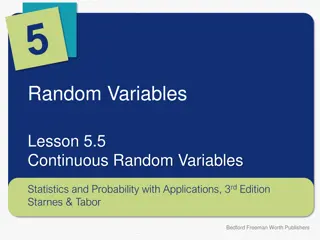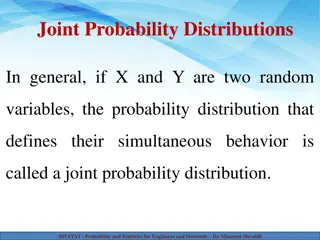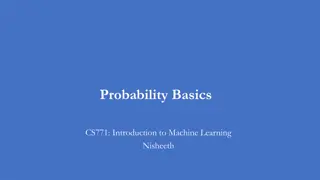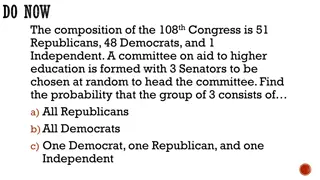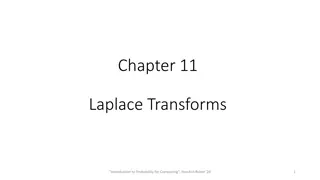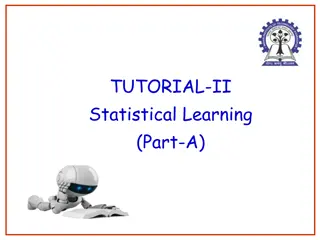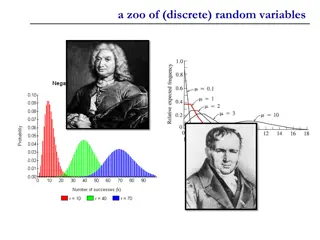Understanding Joint Densities and Probability for Continuous Random Variables
Explore the concepts of joint densities and probability for continuous random variables through examples like meeting times, electrical components' lifetimes, and marginal densities in various scenarios. Learn to calculate probabilities, verify density functions, find joint CDFs, and analyze random variable behaviors.
Download Presentation

Please find below an Image/Link to download the presentation.
The content on the website is provided AS IS for your information and personal use only. It may not be sold, licensed, or shared on other websites without obtaining consent from the author. Download presentation by click this link. If you encounter any issues during the download, it is possible that the publisher has removed the file from their server.
E N D
Presentation Transcript
Chapter 25: Joint Densities http://www.alexfb.com/cgi-bin/twiki/view/PtPhysics/WebHome
Probability for two continuous r.v. http://tutorial.math.lamar.edu/Classes/CalcIII/DoubleIntegrals.aspx
Example 1 (class) A man invites his fianc e to a fine hotel for a Sunday brunch. They decide to meet in the lobby of the hotel between 11:30 am and 12 noon. If they arrive a random times during this period, what is the probability that they will meet within 10 minutes? (Hint: do this geometrically)
Example: FPF (Cont) 40 30 20 10 0 -10 0 10 20 30 40 -10
Example 2 (class) Consider two electrical components, A and B, with respective lifetimes X and Y. Assume that a joint PDF of X and Y is fX,Y(x,y) = 10e-(2x+5y), x, y > 0 and fX,Y(x,y) = 0 otherwise. a) Verify that this is a legitimate density. b) What is the probability that A lasts less than 2 and B lasts less than 3? c) Determine the joint CDF. d) Determine the probability that both components are functioning at time t. e) Determine the probability that A is the first to fail. f) Determine the probability that B is the first to fail.
Example 2d t t
Example 2e y = x
Example 2e y = x
Example 3 Suppose a random variables X and Y have a joint density given by: ??,??,? = ??? 0 0 < ?,? < 2 ???? Find the constant k so that this function is a valid density.
Example 4 (class) Suppose a random variables X and Y have a joint density given by: ??,??,? = ? + ? 0 < ?,? < 1 ???? 0 a) Verify that this is a valid joint density. b) Find the joint CDF. c) From the joint CDF calculated in a), determine the density (which should be what is given above).
Example: Marginal density (class) A bank operates both a drive-up facility and a walk-up window. On a randomly selected day, let X = the proportion of time that the drive-up facility is in use (at least one customer is being served or waiting to be served) and Y = the proportion of time that the walk-up window is in use. The joint PDF is 6(x y ) 0 f (x,y) 5 0 + + 2 x 1,0 y 1 = = X,Y else a) What is fX(x)? b) What is fY(y)?
Example: Marginal density (homework) A nut company markets cans of deluxe mixed nuts containing almonds, cashews and peanuts. Suppose the net weight of each can is exactly 1 lb, but the weight contribution of each type of nut is random. Because the three weights sum to 1, a joint probability model for any two gives all necessary information about the weight of the third type. Let X = the weight of almonds in a selected can and Y = the weight of cashews. The joint PDF is 24xy 0 x f (x,y) 0 + + 1,0 y 1,x y 1 = = X,Y else a) What is fX(x)? b) What is fY(y)?
Chapter 26: Independent Why s everything got to be so intense with me? I m trying to handle all this unpredictability In all probability -- Long Shot, sung by Kelly Clarkson, from the album All I ever Wanted; song written by Katy Perry, Glen Ballard, Matt Thiessen
Example: Independent R.V.s A bank operates both a drive-up facility and a walk-up window. On a randomly selected day, let X = the proportion of time that the drive-up facility is in use (at least one customer is being served or waiting to be served) and Y = the proportion of time that the walk-up window is in use. The joint PDF is 6(x y ) 0 f (x,y) 5 0 + + 2 x 1,0 y 1 = = X,Y else ??? =6 5? +2 5,??? =3 5+6 5?2 Are X and Y independent?
Example: Independence Consider two electrical components, A and B, with respective lifetimes X and Y with marginal shown densities below which are independent of each other. fX(x) = 2e-2x, x > 0, fY(y) = 5e-5y, y > 0 and fX(x) = fY(y) = 0 otherwise. What is fX,Y(x,y)?
Example: Independent R.V.s (homework) A nut company markets cans of deluxe mixed nuts containing almonds, cashews and peanuts. Suppose the net weight of each can is exactly 1 lb, but the weight contribution of each type of nut is random. Because the three weights sum to 1, a joint probability model for any two gives all necessary information about the weight of the third type. Let X = the weight of almonds in a selected can and Y = the weight of cashews. The joint PDF is 24xy 0 x f (x,y) 0 + + 1,0 y 1,x y 1 = = X,Y else Are X and Y independent?
Chapter 27: Conditional Distributions Q : What is conditional probability? A : maybe, maybe not. http://www.goodreads.com/book/show/4914583-f-in-exams
Example: Conditional PDF (class) Suppose a random variables X and Y have a joint density given by: ??,??,? = ? + ? 0 < ?,? < 1 ???? 0 a) Calculate the conditional density of X when Y = y where 0 < y < 1. b) Verify that this function is a density. c) What is the conditional probability that X is between -1 and 0.5 when we know that Y = 0.6. d) Are X and Y independent? (Show using conditional densities.)



